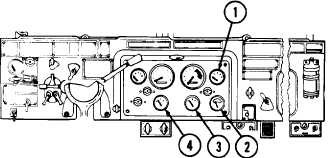TM 9-2320-260-10
2-32. OPERATING IN EXTREME COLD
a. General. The operator must always be alert to changes in weather. The operator
must take care of assigned vehicle in order to prevent damage to vehicle because of
sudden changes in weather. The operator should be cautious when starting or driving a
vehicle that has not been operated for a long period. Lubricants may thicken and cause
parts failure. Tires may freeze to the ground or may freeze flat on the bottom if under-
inflated. The operator should be alert to such possibilities in order to prevent damage to
the vehicle.
b. Before Operation.
(1) Perform all before operation services listed in table 2-2 preventive maintenance
checks and services.
(2) Install warm batteries in vehicle before starting engine coolant heater.
(3) Refer to paragraph 2-13 for cold weather starting instructions.
(4) If vehicle is equipped with arctic winterization kit, refer to paragraph 2-43 for
description and operating instructions.
c. Starting Engine.
CAUTION
Shut down engine coolant heater before starting vehicle engine.
(1) Start engine when engine coolant temperature reads 120°F (49°C) or higher as
indicated by temperature gage (1). Refer to paragraph 2-13 for cold weather starting
instructions if necessary.
(2) After engine starts, warm up engine until temperature gage (1) reads
approximately 140°F (60°C).
CAUTION
Do not shut down engine if temperature gage reads less than
125°F (51.6°C). Run engine 800 to 1000 rpm as indicated by
tachometer until coolant temperature is at least 125°F (51.6°C).
TA 094415
2-200

